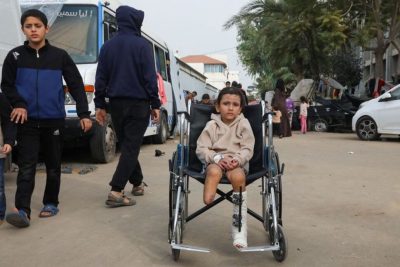More Israeli War Crimes: Gaza’s Child Amputees Face Further Risks Without Expert Care

All Global Research articles can be read in 51 languages by activating the Translate Website button below the author’s name (only available in desktop version).
To receive Global Research’s Daily Newsletter (selected articles), click here.
Click the share button above to email/forward this article to your friends and colleagues. Follow us on Instagram and Twitter and subscribe to our Telegram Channel. Feel free to repost and share widely Global Research articles.
New Year Donation Drive: Global Research Is Committed to the “Unspoken Truth”
***
Apart from the obvious, also sending to demonstrate again that even for the most unlikely, this massacre is proving a desert too far.
That Reuters and US News should be openly critical of the shimmering “democracy” is surely quite something.
—Felicity Arbuthnot, Global Research, January 9, 2024
*
Eleven-year-old Noor’s left leg was almost entirely torn off when her home in Jabalia, Gaza was hit by an explosion in October. Now her right leg, fitted with a heavy metal bar and four screws drilled into the bone, may have to be amputated.
“It hurts me a lot … I’m afraid that they’ll have to cut off my other leg,” she said from her hospital bed, staring at her clunky fixation device.
“I used to run and play, I was so happy with my life, but now when I lost my leg, my life became ugly and I got sad. I hope I can get an artificial limb.”
In bombed-out Gaza, a generation of child amputees is emerging as Israel’s retaliatory blitz after Hamas’ deadly Oct. 7 attacks has led to blast and crush injuries as explosive weapons tear through densely-packed high-rise housing blocks.
Israeli authorities have previously said they work to minimise harm to civilians. Israel’s military spokesperson’s unit pointed to what it called Hamas’ strategy of the “exploitation of civilian structures for terror purposes” but provided no specific comment on child amputees.
Doctors and aid workers say Gaza’s collapsed medical system is ill-placed to give children the intricate follow-up care they need to salvage their still-growing, truncated bones. Only 30% of pre-conflict medics are working due to killings, detentions and displacements, according to the World Health Organization.
More than 1,000 children had undergone leg amputations, sometimes more than once or on both legs, by end-November, according to U.N. children’s agency UNICEF, in a conflict where Gaza health authorities say nearly a quarter of injuries are among children.
Click here to read the full article.
*
Note to readers: Please click the share button above. Follow us on Instagram and Twitter and subscribe to our Telegram Channel. Feel free to repost and share widely Global Research articles.
Featured image: Palestinian girl Eman Al-Kholi, whose limb was amputated after being wounded in an Israeli strike that killed her parents, looks on as she sits in a wheelchair at the European Hospital, in Rafah in the southern Gaza Strip, December 28, 2023. REUTERS/Arafat Barbakh


